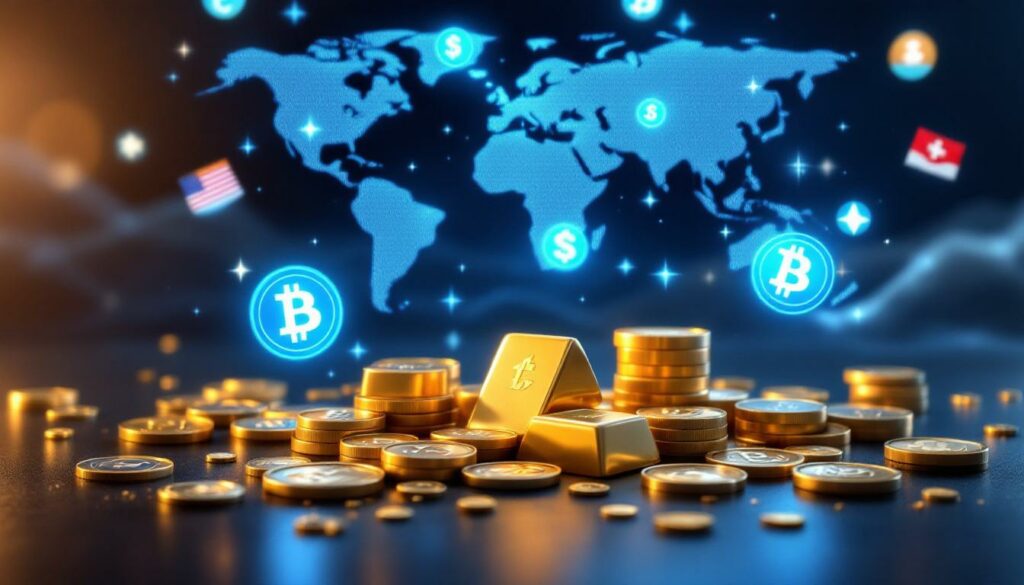What Makes Gold and Silver Relevant in the Digital Age?
In an era dominated by digital currencies and electronic transactions, physical precious metals maintain a unique and enduring value proposition. Gold and silver in an era of digital currencies continue to serve as foundational assets in modern investment portfolios, offering tangible benefits that digital alternatives simply cannot replicate.
The Fundamental Value Proposition of Precious Metals
Physical gold and silver represent tangible wealth that exists independently of the digital ecosystem. Unlike cryptocurrencies or digital assets, precious metals require no electricity, internet connection, or technological infrastructure to maintain their value. This fundamental characteristic remains one of their strongest appeals in an increasingly virtual financial landscape.
The historical precedent for precious metals spans millennia, with gold and silver serving as monetary standards across diverse civilizations and economic systems. This extensive track record contrasts sharply with the relatively brief existence of digital currencies.
Limited supply represents another critical factor in precious metals' enduring relevance. While digital currencies can sometimes replicate scarcity through code, precious metals derive their scarcity from geological reality. The Earth contains finite amounts of these elements, and they cannot be "printed" or created through algorithm adjustments.
"Physical gold and silver provide a form of financial insurance that exists completely outside the digital realm. When electricity fails or digital systems falter, tangible assets remain accessible." — World Gold Council, 2023 Annual Report
During financial system disruptions, precious metals have repeatedly demonstrated their value as portfolio stabilizers. Historical data from the 2008 financial crisis shows gold as inflation hedge appreciated approximately 25% while most financial assets declined sharply.
The Digital Currency Comparison
While cryptocurrencies offer decentralization benefits, they remain fundamentally dependent on technological infrastructure. Bitcoin may operate without central bank control, but it requires functioning internet, electricity, and computer networks—dependencies that physical gold and silver do not share.
From a portfolio diversification perspective, precious metals provide unique benefits:
- Low correlation to both traditional financial assets and digital currencies
- Inflation protection through their limited supply characteristics
- Crisis insurance independent of digital systems
- Privacy benefits without technical complexity
- Jurisdictional diversification through physical portability
According to the World Gold Council's 2024 data, gold has maintained a negative correlation (-0.78) with the U.S. Dollar Index since 2020, highlighting its role as a currency hedge. Silver, while more volatile, demonstrates similar counter-cyclical properties during periods of currency weakness.
Regulatory certainty represents another significant advantage for precious metals. While cryptocurrencies face evolving regulatory frameworks worldwide, physical gold and silver operate within well-established legal structures. Recent cryptocurrency regulatory challenges in major markets contrast with the settled status of precious metals.
Why Are Production-to-Price Ratios Important for Precious Metals Investors?
Understanding the relationship between production volumes and market prices provides critical insights for precious metals investors. These ratios often reveal potential mispricings and investment opportunities not immediately apparent to casual market observers.
The Surprising Production Disparities
One of the most striking aspects of precious metals markets involves the dramatic disparities between production volumes and relative prices. According to the U.S. Geological Survey's 2024 Mineral Commodity Summaries:
- Annual silver production exceeds gold by approximately 20 times in tonnage
- Platinum and palladium production volumes are dramatically lower at only about 180 tons annually
- Despite this scarcity, platinum trades at roughly one-third the price of gold
These production anomalies create fascinating investment considerations. The gold-silver ratio insights has undergone a remarkable historical transformation, shifting from approximately 5:1 in ancient times to around 100:1 today. This price relationship appears disconnected from actual production ratios.
As Clem Chambers, CEO of Online Blockchain PLC, notes: "Platinum should be $60,000 per ounce if priced purely according to its scarcity relative to gold. These production-to-price metrics are completely out of whack, creating potential opportunities for informed investors."
The LBMA (London Bullion Market Association) data from May 2025 confirms this pricing anomaly, with platinum trading at approximately $980 per ounce compared to gold's $2,300 per ounce, despite platinum's significantly lower production volume.
Demand Factors Affecting Price Relationships
Several demand-side factors help explain these seemingly illogical price relationships:
-
Cultural and jewelry demand overwhelmingly favors gold despite its relative abundance compared to platinum group metals. According to the De Beers 2024 Diamond Insight Report, gold dominates 70% of bridal jewelry markets compared to platinum's 7% share.
-
Industrial applications create different demand dynamics across metals. Silver's industrial use accounts for approximately 54% of annual demand according to the Silver Institute's 2024 report, creating price drivers beyond investment demand.
-
Institutional investment preferences traditionally favor gold, with central banks and sovereign wealth funds allocating significant resources to gold reserves while largely ignoring other precious metals.
-
Market liquidity varies dramatically across metals, with gold's daily trading volume exceeding $150 billion compared to platinum's $4.7 billion, according to the World Gold Council's 2024 market analysis.
The CME Group Metals Volatility Index (May 2025) highlights another important consideration for investors: palladium demonstrates 30-day volatility of 35% compared to gold's 12%, reflecting these market size differentials and creating both risks and opportunities.
How Do Global Currency Movements Impact Precious Metal Prices?
Precious metal prices reflect not just their intrinsic value but also their relationship to the global currency ecosystem. Understanding these monetary dynamics provides essential context for precious metals investors.
The Dollar Relationship
Gold price movements often reflect dollar strength rather than changes in gold's intrinsic value. When examining gold prices analysis 2025, investors must remember they're viewing gold through the lens of a specific currency—typically the U.S. dollar.
The Federal Reserve's data shows the Dollar Index (DXY) stood at 104.7 as of May 2025, down approximately 8% from its 2023 peak. During this period of dollar weakness, gold prices appeared to "rise" in dollar terms, though gold's purchasing power remained relatively stable.
Current dollar valuation appears historically elevated against major currencies when viewed through long-term metrics like purchasing power parity and trade-weighted indices. This currency context becomes crucial when evaluating precious metal price movements.
Interest rate policies directly impact currency valuations and precious metal prices. The inverse relationship between real interest rates and gold prices has been well-documented, with Bloomberg's 2025 Analysis showing gold's correlation to the 10-year real yield at -0.82 over the past decade.
"Gold doesn't rise in price—currencies fall against it. It's important to view precious metals as monetary constants rather than as appreciating assets." — Clem Chambers
International Capital Flows
Global capital movements significantly influence precious metals markets. Several major trends deserve attention:
- Chinese reduction in U.S. Treasury holdings from $1.3 trillion to approximately $800 billion (confirmed by U.S. Treasury TIC Data, March 2025)
- Middle Eastern countries using gold to maintain dollar exposure while hedging currency risk
- Japanese investors seeking alternatives to domestic bonds in precious metals markets
- Global institutional capital increasingly diversifying monetary reserves with physical gold
These capital flows represent significant market-moving forces. The reduction in Chinese Treasury holdings alone represents half a trillion dollars potentially seeking alternative stores of value, including precious metals.
Sophisticated international investors increasingly use precious metals as currency hedges rather than as speculative assets. This monetary function becomes particularly important during periods of currency volatility or when geopolitical tensions threaten traditional reserve currencies.
What Drives Institutional Investment in Precious Metals?
Institutional investment represents a powerful force in precious metals markets, with central banks, sovereign wealth funds, and pension systems allocating significant capital to these assets. Understanding these professional investment patterns provides valuable context for individual investors.
Central Bank Acquisition Trends
Central banks have undertaken record gold purchases in recent years, with the World Gold Council's 2024 data confirming 1,136 tons acquired in 2023 alone. This institutional buying represents a significant shift from the net-selling environment that characterized earlier decades.
Several factors drive this central bank enthusiasm for gold:
- Diversification away from dollar-denominated assets as part of reserve management strategy
- Geopolitical tensions driving strategic reserve building outside traditional financial systems
- Emerging market central banks increasing allocations to reduce dependence on foreign currencies
- Protection against currency debasement during unprecedented global monetary expansion
The significance of China's gold acquisition program deserves particular attention. While official reports from the People's Bank of China indicate modest increases in gold reserves, many analysts suspect actual acquisition volumes substantially exceed reported figures.
Banking system fragility concerns have also accelerated institutional interest in precious metals. The 2023 regional banking crisis in the United States prompted increased institutional allocations to gold as a form of systemic risk insurance.
Sovereign Wealth Fund Strategies
Sovereign wealth funds, which collectively manage over $10 trillion in assets, have gradually increased precious metals allocations. According to the SWFI 2024 Global Asset Report, these funds now allocate an average of 6% to commodities, including significant precious metals exposure.
These sovereign institutions value precious metals for several strategic reasons:
- Portfolio diversification beyond traditional financial assets
- Physical gold holdings as crisis insurance against systemic financial risks
- Precious metals as a counterbalance to equity market exposure
- Strategic resource acquisition versus purely financial investment
- Long-term horizon matching precious metal characteristics
Norway's Government Pension Fund Global, the world's largest sovereign wealth fund, increased its gold mining equity exposure by 30% in 2024, reflecting growing institutional confidence in the sector.
How Does China's Financial Position Impact Precious Metals Markets?
China's financial strategies significantly influence global precious metals markets through both direct participation and indirect effects on the international monetary system.
China's Monetary Influence
China reportedly holds approximately 1.8 times the monetary reserves of the United States, with IMF COFER Q1 2025 data confirming China's official reserves at $3.2 trillion compared to U.S. reserves of $1.8 trillion. This reserve imbalance creates significant implications for global monetary dynamics.
China's controlled currency convertibility represents a strategic policy choice that prevents the yuan from achieving full reserve currency status. This limitation maintains China's financial sovereignty while preventing the "exorbitant privilege" currently enjoyed by the U.S. dollar.
Gold and silver in an era of digital currencies play a special role in China's financial strategy, serving as both a dollar hedge and a sovereign asset outside the Western-dominated financial system. As Clem Chambers notes, "Gold anchors China's financial strategy, providing a monetary constant while they navigate currency policy."
The potential impact if China were to liberalize currency controls would be substantial for precious metals markets. A fully convertible yuan might reduce gold's monetary role, though geopolitical considerations suggest China would maintain significant precious metals reserves regardless of currency policy changes.
Trade Balances and Metal Flows
China's persistent trade surpluses have facilitated significant precious metal accumulation. The relationship between these trade surpluses and metal acquisition follows a logical pattern—countries generating dollar surpluses have historically converted portions of these surpluses to gold.
China's strategic resource acquisition programs extend beyond gold to industrial precious metals, particularly those with technological applications. Silver, platinum, and palladium play crucial roles in manufacturing sectors where China maintains dominance.
The country's currency management strategies involve precious metals as stabilizing influences within a broader portfolio approach. While direct market intervention through metal sales remains rare, China's substantial holdings create market-moving potential.
Long-term implications for global pricing mechanisms include China's growing influence in setting physical premiums for metals in Asian markets. The Shanghai Gold Exchange increasingly competes with London and New York in price discovery functions.
What Role Do Precious Metals Play During Periods of Geopolitical Tension?
Geopolitical uncertainty consistently drives interest in precious metals as safe haven assets. Understanding how these assets perform during various types of international tensions helps investors prepare for potential portfolio stresses.
Historical Performance During Conflicts
Gold has traditionally functioned as a "war asset" during global tensions, with Bloomberg data showing gold appreciated 18% during the 2024 Taiwan Strait crisis. This performance pattern has repeated across numerous conflicts, though with varying magnitudes.
Price performance during regional conflicts depends significantly on the conflict's potential impact on global financial systems. Localized conflicts with minimal international economic implications typically generate more modest precious metals responses.
Research from Citi in 2025 identified a strong correlation between defense spending increases and precious metal prices, with an R² of 0.72 between NATO defense budgets and gold prices from 2010-2024. This relationship suggests monitoring defense appropriations provides valuable signals for metals investors.
Physical metal transportation and custody during unstable periods present unique challenges and opportunities. Premium differentials between major trading hubs often widen during geopolitical crises, creating arbitrage opportunities for sophisticated market participants with secure logistics capabilities.
Strategic National Considerations
Resource nationalism increasingly affects mining jurisdictions worldwide. Countries with significant mineral deposits increasingly view these resources as strategic assets rather than purely economic ones. This trend manifests through:
- Increased royalty and tax regimes in major mining countries
- Export restrictions during periods of tension
- Mandatory domestic processing requirements
- State participation in mining enterprises
- Strategic stockpiling programs
Geographic concentration of production and refining creates supply vulnerabilities that informed investors must monitor. The USGS Critical Minerals Report highlights that 85% of platinum group metal production remains concentrated in just two countries—South Africa and Russia—creating significant supply risk during geopolitical tensions.
How Should Investors Approach Precious Metals Storage and Custody?
The physical nature of precious metals requires careful consideration of storage and custody arrangements. Unlike purely financial assets, physical metals demand security solutions that balance protection, access, and cost concerns.
International Storage Considerations
Geographic diversification for physical holdings provides significant benefits beyond simple security. Distributing precious metals holdings across multiple jurisdictions protects against country-specific risks like asset freezes, capital controls, or political instability.
Switzerland maintains its traditional role as a premier precious metals custody center, combining political neutrality, sophisticated security infrastructure, and favorable regulatory treatment. As Clem Chambers notes, "Switzerland's political neutrality makes it ideal for custody" of physical precious metals.
Jurisdictional risk assessment should consider factors beyond immediate security concerns:
| Jurisdiction Factor | Considerations |
|---|---|
| Property rights protection | Legal system strength and history |
| Political stability | Long-term governance trends |
| Regulatory environment | Treatment of precious metals ownership |
| Tax implications | Reporting requirements and taxation |
| Physical access | Travel restrictions and border controls |
| Insurance availability | Coverage options and costs |
According to SWP Cayman Vault's 2025 Fee Schedule, Swiss storage costs typically range from 0.15% to 0.25% annually, representing a modest carrying cost for physical metal holdings compared to management fees for many financial assets.
Physical Versus Synthetic Exposure
Investors must carefully evaluate different methods of precious metals ownership, each offering distinct advantages and limitations:
Direct ownership of physical metals eliminates counterparty risk but introduces storage and insurance considerations. Physical metals remain accessible during financial system disruptions but may present liquidation challenges during crises.
Exchange-traded funds (ETFs) offer convenience and liquidity but introduce dependence on financial market functioning. The counterparty risk assessment for different investment vehicles should evaluate:
- Custodian financial strength
- Regulatory oversight quality
- Redemption mechanisms
- Insurance coverage
- Audit verification processes
Tax implications vary significantly across ownership structures. Physical metals held personally often receive different tax treatment than exchange-traded products or mining shares, with important variations across jurisdictions.
What Portfolio Allocation Strategies Work Best for Precious Metals?
Integrating precious metals effectively into investment portfolios requires thoughtful allocation strategies that maximize diversification benefits while managing volatility and carrying costs.
Diversification Within Metals
Balancing exposure across different precious metals helps optimize risk-adjusted returns. Each metal offers distinct characteristics:
- Gold: Lowest volatility, strongest monetary characteristics
- Silver: Higher industrial demand, greater volatility, lower unit cost
- Platinum: Primarily industrial, significant production concentration
- Palladium: Highest volatility, specialized industrial applications
The volatility profiles of different precious metals create both challenges and opportunities. According to the CME Group Metals Volatility Index (May 2025), palladium demonstrates 30-day volatility of 35% compared to gold's 12%, reflecting significant differences in market size and liquidity.
Industrial versus monetary demand impacts create different performance patterns across metals. Silver market squeeze industrial demand component (approximately 54% according to the Silver Institute) makes it more responsive to economic activity than gold, which responds primarily to monetary and investment factors.
Rebalancing strategies for metal allocations should consider both relative value and volatility management. Many professional investors establish target ratios between metals and rebalance when market movements create significant deviations from these targets.
Overall Portfolio Integration
Traditional allocation recommendations suggest 5-10% of portfolio assets in precious metals. The CFA Institute's 2024 Portfolio Study indicates this allocation range has historically reduced overall portfolio volatility by approximately 30% during periods of financial stress.
Correlation benefits with traditional financial assets represent a primary motivation for precious metals inclusion. During the 2
Want to Capitalise on the Next Major Mineral Discovery?
Discover why significant ASX mineral discoveries can generate substantial returns by exploring Discovery Alert's dedicated discoveries page, where the proprietary Discovery IQ model instantly converts complex mineral data into actionable investment insights. Begin your 30-day free trial today at https://discoveryalert.com.au/discoveries/ to position yourself ahead of the market with real-time alerts on high-potential opportunities.




